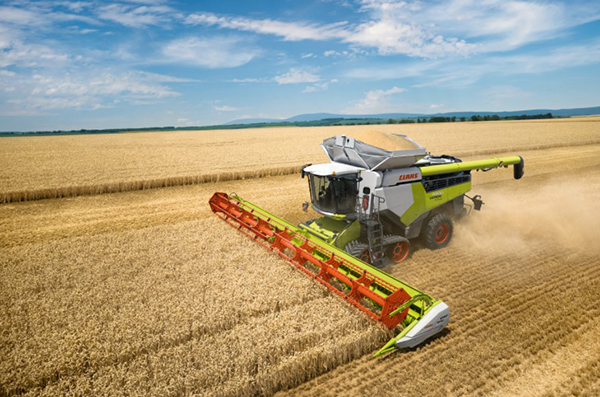
|
PDM/PLM provides the foundation for digital transformationAn interview with Dr. Kai Korthals The products from agricultural machinery manufacturer CLAAS are becoming ever more complex, and this also true of the associated development processes. Talking to PROSTEP Newsletter, Dr. Kai Korthals, Head of Digital Product Engineering, explains how CLAAS intends to master this increasing complexity and looks at the role that PDM/PLM is playing in the company’s digitalization strategy. 
Question: How important a role are product-service systems playing in CLAAS’s product portfolio now? Korthals: That depends on what you mean by a product-service system. If you mean supplementary services such as predictive maintenance as part of the after sales service or features such as software updates over the air, it is an area of growing importance for us and represents a major challenge. Question: What new requirements arise from this with regard to product development? Korthals: In particular, we have to take solution-neutral customer requirements as a basis for integrating software development, balancing processes and methods from the very beginning. Which is why model-based systems engineering (MBSE) is a very important topic for us. In addition, seemingly mundane topics such as the quality of master data, which we have been working on ever since the advent of PDM, are enjoying something of a renaissance. Even the topic of the end-to-end use of 3D, which is not in itself new, is taking on a new dimension. Suddenly, we find ourselves collaborating with game vendors like GIANTS, who use our 3D models for their farm simulators and in return provide us with rendered models for our sales activities. The coronavirus pandemic in particular has increased demand for virtual sales meetings and training sessions with customers, for example, where we use animated renderings to show them how to get into the cab. Question: What does this mean for your digitalization strategy? Where are the key fields of activity? Korthals: There are a number of pillars to our digitalization strategy: modeling and connecting with MBSE, visualization, i.e. the issue of digital continuity with a focus on 3D, and validation using simulations, which is an aspect that should not be overlooked in the wider discussion about digital transformation. In other words, the basic topics remain the same as they were ten years ago. What has changed is the way in which these topics and, indeed, the data models are interlinked. I can map these connections using MBSE, but I also need the link to the tasks in project management or to the configuration for production. Which brings us on to the issue of traceability. Question: Is traceability driven more by the complexity of product development or the legal burden of proof? Korthals: Traceability remains important in the context of functional safety, but with regard to the product service systems already mentioned or to autonomous systems, mastery of the technical, process-related and organizational complexity is becoming increasingly important. You can’t negate the complexity. Instead, you have to make it manageable. For this, we need MBSE and configuration management throughout the lifecycle in order to make the interrelationships easier to understand. 
Question: You just said that MBSE is an important topic for you. What do you see as the main drivers of this approach? Korthals: There are undoubtedly a number of different drivers, but they can be grouped together under the term complexity. Ultimately, it is the growing proportion of software, the interconnected development of cross-product features and globally distributed development that lead to increasing complexity at the product, process and organizational level. Question: You get the impression that CLAAS is to a certain extent pioneering the use of MBSE. Is this the case? Korthals: That is for others to judge, but we are of course represented in a large number of working groups and we see what other companies are doing. So I think I have some justification in saying that we have a very holistic approach to the topic and have already made considerable progress. Question: To what extent has what you have validated in the Systems Engineering Solution Lab already been implemented in the product development process? Korthals: The various aspects are at present being rolled out one by one. We are currently rolling out validation management. But we are not migrating all ongoing development projects to the new process and the new tool environment in a big bang, because that would inhibit the projects. Instead, we are introducing it gradually across the projects until we reach a tipping point, as the users in cross-sectional functions have a vested interest in avoiding the use of parallel systems. Question: Does PDM/PLM still play an important role in your digitalization strategy? Korthals: Yes, absolutely. Our digitalization strategy has three major pillars. Firstly, we want to digitalize our interaction at the point of contact with the customer and thus make it independent of time and place. The second is the empowerment of our employees, i.e. we want to drive digital transformation as a change process. And the third major pillar is the topic of the digital enterprise, which break down to the level of Industry 4.0. PDM/PLM is in many cases the enabler that brings together the internal view, external view and empowerment. Without this foundation, digital transformation simply collapses like a house of cards. Question: You are working very closely with Dassault Systèmes to implement your digitization strategy. Is your broad PDM/PLM vision feasible with a monolithic system landscape? Korthals: Your question is understandable. PLM experts have for years been promoting the idea that monolithic systems are dead. We are aware of the fact that we are to a certain extent placing ourselves in a position of dependency, but we have done very well with Dassault so far. You have to remember that we are not just a customer, but a strategic R&D partner and write user stories for the developers in Vélizy, so our needs are implemented very quickly. Not only that, we don’t source all of our expert systems and authoring systems from Dassault. There are certain environments for software development and simulation that we will not be replacing. At the system level, however, the opportunities offered by a monolithic approach outweigh the risks. Question: In what use cases are you already using digital twins? Korthals: We don’t use the term ‘digital twin’ at CLAAS yet, partly because of our experience with the introduction of systems engineering. When we started using it five years ago, we tried to avoid coining some grand, new term without any concrete benefit for the user being apparent, because that simply discourages people. Although we had our strategy in mind, we approached the issue very much on the basis of use cases. And we’re doing something similar with the digital twin. We have plenty of very concrete use cases, for instance moving maintenance documentation to a kinematic DMU to show a service technician in Uzbekistan how to change the oil filter without the need for words. But we don’t refer to this as a digital twin. 
Question: How important is the East Westphalia cluster for CLAAS? Korthals: The cluster is extremely important to us. From our Systems Engineering Solutions Lab, we have started research projects together with Fraunhofer IEM, one of which has been merged into it’s OWL. And then there is the MOSYS project for human-oriented systems engineering, which is funded by the German Ministry of Education and Research. Collaboration with other it’s OWL partners such as Miele allows us to discuss our future needs and system requirements. The research projects have also allowed us to hire additional staff for our Solution Labs, which helps us to become faster. Question: What needs and system requirements do you see in the future? Korthals: As I have already said, connecting and visualizing information is currently a big driver for us. It is only this combination that makes complexity really comprehensible and thus manageable. In our Solution Labs, we have found out that we can build databases to connect certain artifacts with each other, requirements with test cases, or with architecture models, with CAD models, with circuit diagrams and so on. But the problem is that at the end of it all, no normal person has any hope of understanding it. That’s why we have to be able to pull out these relationships in a way that is specific to the application and the user and, where possible, visualize them in the 3D model in order to quickly make the complexity understandable across different locations, languages and roles. Mr. Korthals, thank you very much for talking to us. (This interview was conducted by Michael Wendenburg)

Dr. Kai Korthals has worked for agricultural machinery manufacturer CLAAS since 2014 and is currently Head of Digital Product Engineering. In this role, he and his team are responsible for the CLASS engineering system. This comprises the engineering processes, methods, data models and applications for CAD, PDM/PLM and systems engineering. Korthals studied industrial engineering, majoring in mechanical engineering and production technology at RWTH University in Aachen. He subsequently completed his doctorate at the RWTH’s machine tool laboratory in the field of production-oriented product development. |
|
| © PROSTEP AG | ALL RIGHTS RESERVED | IMPRINT | PRIVACY STATEMENT | YOU CAN UNSUBSCRIBE TO THE NEWSLETTER HERE. |
